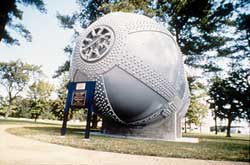
First operational in 1922, the Variable Density Tunnel at the Langley Research Center in Hampton, Virginia, was the first wind tunnel in the world to use the principle of variable density air pressure to test scale model aircraft and it established the National Advisory Committee for Aeronautics (NACA) as a technically competent research facility. Max Munk, a German NACA technical assistant who was familiar with European wind tunnel design, designed the Variable Density Tunnel--the first pressurized wind tunnel in the world. The Variable Density Tunnel was able to predict flow characteristics of test aircraft models more accurately than any other tunnel in existence at that time. In 1927 the Variable Density Tunnel was partially destroyed by a fire that damaged its interior. The tunnel was rebuilt and operational by 1930.
The Variable Density Tunnel was deemed obsolete by the standards of the day in the 1940s and was gutted. It was then used as a pressure tank to support the operation of the Vertical Wind Tunnel and Low Turbulence Wind Tunnel. Although declared potentially unsafe for further operations in 1978, all modern Variable Density Tunnels are merely an extension of this idea first formulated and put into operation by Munk in 1921. The Variable Density Tunnel was a technological jump that rejuvenated American aerodynamic research which had fallen behind European countries prior to World War I and eventually led to the development of the best aircraft in the world.
Visit the National Park Service Travel American Aviation to learn more about Aviation related Historic Sites.
Last updated: August 29, 2017
